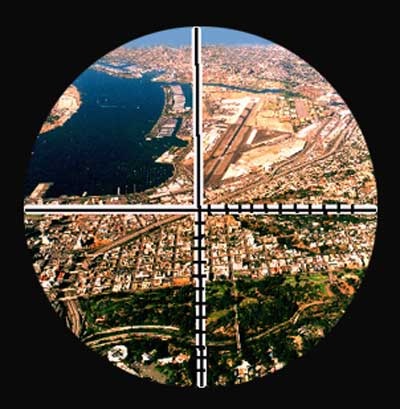
©2004 UrbisMedia
I wrote earlier this month (15.3) that what the right wing calls the “heartland” of America, really isn’t the heartland. And, at least in terms of security, the type of security that “homeland security” is supposed provide us, it is not the “homeland” either.
From the deck of my condo I can make out the fighter planes on two of the three aircraft carriers moored in San Diego bay. With my telescope I can see a couple of nuclear submarines half-submerged in their pens along Pont Loma. San Diego is a beautiful city, sunny and salubrious; but it might as well be renamed Sword of Damocles. That sword, you will recall, once was suspended by a single horse-hair over the head of an ancient Grecian king. San Diego is similarly imperiled, under the cross-hairs of any enemy bent on doing America great harm and diminishing its ability to avenge it.
The form and fates of cities have varied greatly over time, often as a result of the variable of ballistics. In the earliest days of cities a fence, then a wall, provided security, and, as Aristotle, among others, pointed out, people came to cities for safety and also found a better life. Stadt luft mach frei , Germans claimed in the Dark Ages, “city air makes one free.” Outside of city walls things were a lot more dicey.
To be intra muros was to be as safe as one could be for much of urban history. And within the city the safest place to be was the center; it was furthest from the walls. Remember, siege tactics soon discovered that tossing things like fire bombs, and dead animals and diseased bodies (What? You thought Saddam Hussein invented bio-warfare?) over city walls was a good tactic. Soon walls became more complicated, both defensively and offensively. Parapets and devices for repelling attacks were developed, moats were added, and as cannon became a factors, walls were designed to deflect cannon shot.
But eventually, ballistics got so good that walls were an expensive and ineffective defense. What use to build huge walls when a cannon could send shells all the way to the very center of the city. So down came the walls, many becoming ring roads, our boulevards (from bulwarks), and the new tactic was to find out from which direction your enemy was coming and go out and meet him on the field of battle and make sure his cannon could not get close enough to bombard your city. This was the tactic by the early 19 th Century. It lasted for about a century. In WWI armies were still going out and slaughtering one another in the countryside. Cities were relatively safe once again, and the centers the safest.
By WWII that all changed thanks to the Wright Brothers and Werner von Braun. An aerial photo of German and Japanese cities after WWII makes the point better than I ever could. After WWII the British determined to spread their cities out and America came up with the National Defense Highway Program based on the silly idea that when the enemy came calling with their newfound ICBMs we could just get in our SUVs and head for the countryside (oops, Heartland).
But such ballistics are expensive and tricky to deploy, so not every enemy can readily have them. One enemy figured a way to employ makeshift ballistics from their enemy’s own commercial airplanes. Even more difficult for cities to defend against was the emergence of a new and dreaded tactical weapon in the arsenal of some combatants—the human bomb.
Now, even the most powerful nation on the earth cannot build walls high enough, fast enough, or long enough, to defend its “homeland,” to secure its cities. It may go to meet its enemy in the fields, but his fields are far flung, mobile and protean. It may go to vanquish his enemy’s cities, but this will only make new enemies with a resolve to infiltrate our cities, the symbols, as well as the engines of our economic and military power. The enemy knows that every resource that is spent on bombing and occupying his cities weaken the defense of his enemy.
And so I sit on my deck, watching the harbor, wondering. I speculate on the various ways by which a determined enemy might penetrate our flimsy defenses. A tanker or a container ship slips slowly by and it seems it would be so easy for a dirty bomb to be detonated that would kill tens of thousands of military and civilians. I ponder on the fact that what is called Homeland Security is a joke. We have fewer first responders than we did before 9-11, our ports and border are sieves, our airport security can be breached by high school pranksters, we don’t have enough hospital beds, medicines, vaccines, and if we had to evacuate any of our major cities in a hurry the crumpling of fenders would be heard in Baghdad. It’s almost enough to make a guy head for the “heartland.” Almost.
___________________________________
©2004, James A. Clapp (UrbisMedia Ltd. Pub. 12.19.2004)
